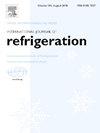Numerical and experimental evaluation of the thermal and dynamic performance of a phase change material in an indirect solar dryer
IF 3.5
2区 工程技术
Q1 ENGINEERING, MECHANICAL
International Journal of Refrigeration-revue Internationale Du Froid
Pub Date : 2025-02-10
DOI:10.1016/j.ijrefrig.2025.02.006
引用次数: 0
Abstract
The use of solar dryers can be limited due to inherent challenges such as the non-uniform final moisture content of the dried product and the non-continuity of the drying process. These drawbacks are mainly due to the uneven distribution of air between the trays and the intermittent availability of solar energy. Consequently, a storage unit is needed to provide heat during cloudy hours or when the sun sets. This study therefore focuses on an indirect solar dryer to identify the best location for a storage unit. Three cases were examined through numerical simulations using ANSYS Fluent, which were validated experimentally: The first case is where the PCM is located under the absorber plate, the second case is where the PCM is located in the plenum, and the third case is where there is no PCM. In order to make this comparison fair, we respected the same amount of PCM in both cases. The results show that the first case outperforms the second in terms of the average temperature inside the drying chamber. However, beyond 8 p.m., the opposite is observed, with the maximum temperature difference from the case without PCM reaching 9 and 8° for the first and second cases respectively. As regards air uniformity, the second case made the air more uniform along the trays compared with the other cases.
相变材料在太阳能间接干燥器中的热动态性能的数值与实验评价
由于固有的挑战,如干燥产品的不均匀的最终水分含量和干燥过程的不连续性,太阳能干燥机的使用可能受到限制。这些缺点主要是由于托盘之间的空气分布不均匀和太阳能的间歇性可用性。因此,需要一个存储单元在阴天或太阳落山时提供热量。因此,本研究的重点是间接太阳能干燥器,以确定存储单元的最佳位置。利用ANSYS Fluent软件对三种情况进行了数值模拟,并进行了实验验证:第一种情况是PCM位于吸收板下方,第二种情况是PCM位于静压室内,第三种情况是没有PCM。为了使这种比较公平,我们在两种情况下都尊重相同数量的PCM。结果表明,在干燥室内平均温度方面,第一种情况优于第二种情况。然而,在晚上8点以后,观察到的情况正好相反,第一个和第二个病例的最大温差分别达到9°和8°。在空气均匀性方面,与其他情况相比,第二种情况使空气沿托盘更加均匀。
本文章由计算机程序翻译,如有差异,请以英文原文为准。
求助全文
约1分钟内获得全文
求助全文
来源期刊
CiteScore
7.30
自引率
12.80%
发文量
363
审稿时长
3.7 months
期刊介绍:
The International Journal of Refrigeration is published for the International Institute of Refrigeration (IIR) by Elsevier. It is essential reading for all those wishing to keep abreast of research and industrial news in refrigeration, air conditioning and associated fields. This is particularly important in these times of rapid introduction of alternative refrigerants and the emergence of new technology. The journal has published special issues on alternative refrigerants and novel topics in the field of boiling, condensation, heat pumps, food refrigeration, carbon dioxide, ammonia, hydrocarbons, magnetic refrigeration at room temperature, sorptive cooling, phase change materials and slurries, ejector technology, compressors, and solar cooling.
As well as original research papers the International Journal of Refrigeration also includes review articles, papers presented at IIR conferences, short reports and letters describing preliminary results and experimental details, and letters to the Editor on recent areas of discussion and controversy. Other features include forthcoming events, conference reports and book reviews.
Papers are published in either English or French with the IIR news section in both languages.

 求助内容:
求助内容: 应助结果提醒方式:
应助结果提醒方式:


